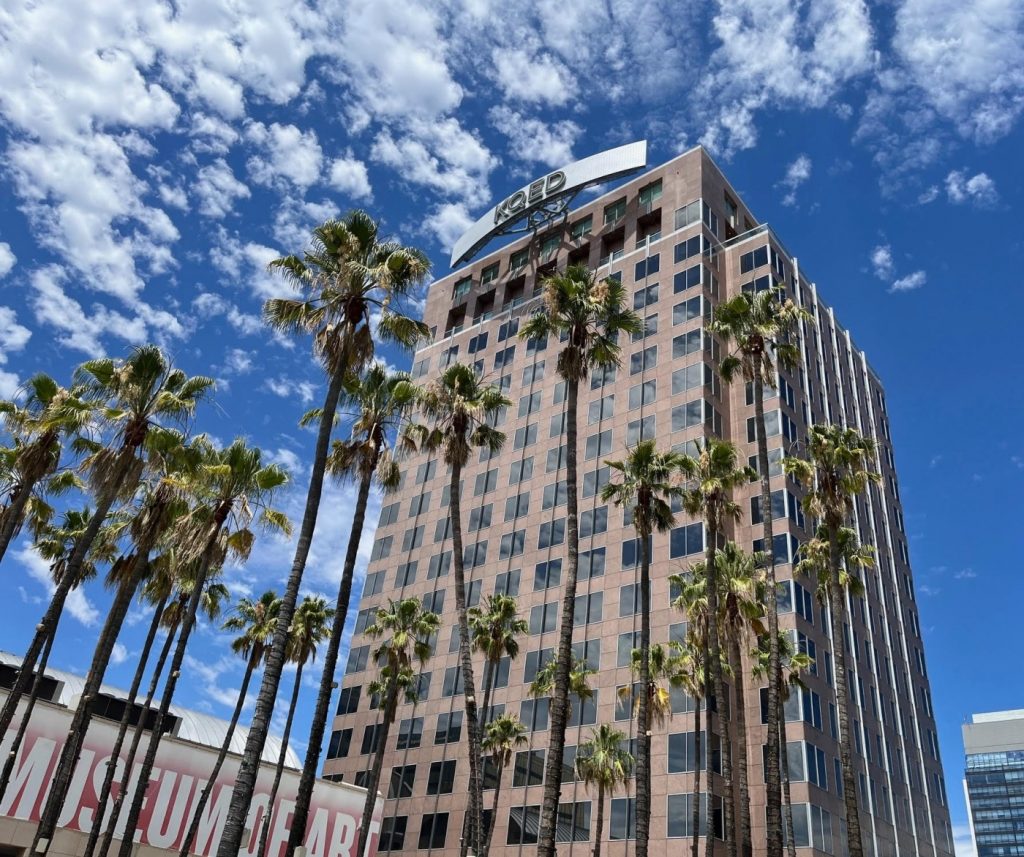SAN JOSE — KQED has decided to close its downtown San Jose office as the media outlet pursues budget cuts, a move that leaves up in the air the future of its high-profile sign atop a prominent highrise.
The public media outlet has decided to terminate its lease at 50 West San Fernando Street in downtown San Jose in an office tower known as 50 West.
50 West office tower at 50 West San Fernando Street in San Jose, as seen from South First Street, 2019. (George Avalos/Bay Area News Group)
“As part of a range of permanent budget cuts KQED is making to confront a growing shortfall, we are letting go of the lease on our small satellite office in downtown San Jose,” said Peter Cavagnaro, a KQED spokesperson.
The public media outlet in recent weeks has launched efforts to trim expenses that have outpaced revenue at KQED. The South Bay office closure is part of the belt-tightening.
“Though not a bureau, a handful of South Bay-based KQED staffers and reporters have used this space since we began leasing it in 2014,” Cavagnaro said.
Since 2016, two KQED signs have been perched at the roofline of the 18-story 50 West office tower, which is at the corner of West San Fernando Street and South First Street.
From 1999 and into 2016 until replaced by the KQED sign, a Knight Ridder sign sat atop the highrise. The Knight Ridder sign remained on the building for years even after that media company had ceased to exist when Knight Ridder was broken up and purchased.
San Francisco-based KQED, one of the nation’s largest public media organizations, is reducing overall staffing throughout the organization by 34 positions.
These consist of the elimination of 19 jobs, 11 voluntary departure offers and the organization’s decision to not fill four vacant positions.
The staffing cutbacks equate to an 8% workforce reduction, KQED estimated.
“A number of public and commercial media companies have recently announced layoffs and deep budget cuts due to the rising costs of doing business in this increasingly tumultuous and fractured media landscape,” KQED president and chief executive officer Michael Isip stated in a May 24 open letter to employees. “KQED is not immune from these challenges.”
KQED also decided to eliminate television pledge drives, effective on Oct. 1, and will eliminate a podcast.
“The cost of television pledge, in terms of thank you gifts, their fulfillment and staff time is high, while the net revenue is relatively small,” Isip stated. “This will allow us to focus resources on finding other ways to grow membership and philanthropic support.”
KQED’s space in the downtown San Jose 50 West building totaled roughly 4,000 square feet.
“Over the years, particularly coming out of the pandemic and since we reopened in our refurbished San Francisco headquarters in 2021, the (San Jose) office has become less used as staff has become more accustomed to hybrid/remote work and some of the upgraded capabilities of the San Francisco headquarters,” Cavagnaro said.
KQED vowed that its coverage of the South Bay market won’t deteriorate in the wake of the San Jose office closure.
The public media firm also stated that none of the staffers who worked regularly out of the San Jose office lost their jobs.
Jay Paul Co., which controls an affiliate that owns the building, didn’t comment about the situation.
KQED confirmed that the two signs will also become casualties of the office shutdown.
“We are also letting go of our KQED brand signage at the top of this location with this move,” Cavagnaro said.


